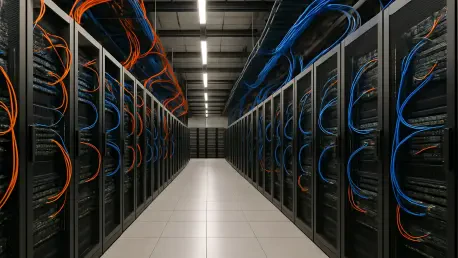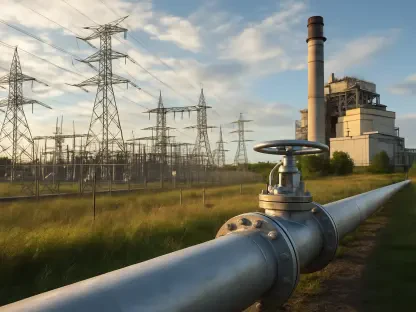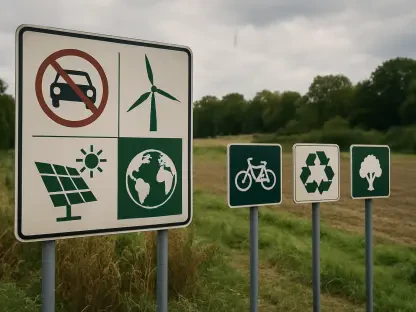The U.S. power grid is grappling with a perfect storm of challenges, as outage durations climb to an average of 12.8 hours during major disruptions, winter demand surges by 20 GW, and debates intensify over the true impact of data centers on electricity load, signaling a critical juncture for the energy market where reliability, capacity, and innovation collide. This analysis dives into the current state of the grid, dissecting key trends, data-driven projections, and market dynamics that shape the sector’s trajectory. By examining systemic vulnerabilities and emerging opportunities, the goal is to provide stakeholders with actionable insights into navigating an increasingly strained energy landscape.
Grid Reliability Crisis: Outages and Weather Impacts
The energy market faces a stark reality as power outages grow longer and more disruptive, driven by extreme weather events that test the limits of aging infrastructure. Recent data reveals that the average duration of the longest outages has reached 12.8 hours, a significant increase over previous benchmarks, reflecting the grid’s struggle to recover from storms, wildfires, and cold snaps. Utilities are caught in a bind, balancing the urgent need for infrastructure upgrades against constrained budgets and lengthy project timelines, which often span years. This reliability crisis not only affects consumers but also rattles investor confidence in utility stocks, as operational risks mount.
Beyond immediate disruptions, the market implications of prolonged outages are profound, influencing everything from insurance costs to regional economic stability. Areas repeatedly hit by natural disasters face higher operational expenses for utilities, which can translate into elevated rates for customers or reduced profit margins for shareholders. Meanwhile, the push for grid hardening—such as burying power lines or upgrading substations—remains a contentious issue, with costs often outweighing short-term financial returns. This dynamic underscores a broader market tension between resilience and profitability, shaping investment strategies in the sector.
Winter Demand Surge: A Capacity Conundrum
Winter peak demand is emerging as a pivotal challenge for the energy market, with the North American Electric Reliability Corporation (NERC) projecting a 20 GW increase, or 2.5% growth, for the current season compared to last year. Some regions are bracing for spikes nearing 10%, driven by electrification of heating systems and shifting population patterns. This rapid demand escalation outpaces the rate of new generation capacity additions, creating a looming risk of shortages during extreme cold, which could destabilize energy prices and strain wholesale markets.
The capacity shortfall is particularly alarming given that resource additions in key areas lag behind projected needs by a notable margin. Market participants face heightened volatility as the gap between supply and demand widens, potentially driving up costs for backup power or emergency measures during peak stress periods. However, opportunities exist for demand-side management solutions, such as incentivizing load reduction during critical times, though scaling these programs to meet unprecedented growth remains a hurdle. Investors and utilities must weigh these risks against potential returns from innovative capacity solutions.
Data Center Load Debate: Market Myths vs. Realities
One of the most polarizing topics in the energy market is the projected load growth tied to data centers, which fuel AI, cloud computing, and digital infrastructure. While utility forecasts initially suggested staggering peak load increases, recent analysis by Grid Strategies indicates an overstatement of about 25 GW, though even adjusted projections point to a 140 GW rise over the next five years. This uncertainty creates a ripple effect across the market, as overblown expectations could lead to misguided capital allocation for new generation projects.
Regional disparities further complicate the outlook, with tech hubs like Northern Virginia witnessing explosive demand growth while other areas remain relatively stable. Recent utility earnings reports showing flat electricity deliveries add another layer of doubt, suggesting that the immediate impact of data centers may be less severe than anticipated. For market players, this ambiguity necessitates a cautious approach, focusing on refined forecasting models to avoid overinvestment in capacity that may not be needed, while still preparing for undeniable long-term growth in digital energy needs.
Policy and Economic Shifts: Navigating Market Incentives
Policy interventions are reshaping the energy market, with initiatives like the Texas Energy Fund securing 3.5 GW of capacity through low-interest loans for projects within the Electric Reliability Council of Texas (ERCOT) region. A recent example includes funding for a 455-MW gas plant near Houston, expected to come online by 2028. However, economic headwinds have led to withdrawals of some gas projects from funding pipelines, reflecting a market shift toward cheaper renewables and highlighting the fragility of traditional energy investments in a transitioning landscape.
Regulatory pressures also play a critical role, as federal and state mandates push for enhanced grid resilience amid growing reliability concerns. The economic viability of gas versus renewable projects is becoming a defining factor for investors, with renewables gaining traction due to declining costs and policy support. Market participants must navigate these shifting incentives, balancing the immediate benefits of policy-backed projects with the long-term uncertainties of energy economics, while anticipating potential federal regulations that could further alter the investment calculus.
Emerging Trends: Technology and Market Transformation
Looking ahead, the energy market stands on the cusp of transformation, driven by technological advancements and evolving consumer demands. The accelerated deployment of renewable energy sources, coupled with energy storage systems, offers a pathway to mitigate demand spikes if scaled effectively across regions. Smart grid technologies, which enable real-time load management, are also gaining momentum as a tool to handle fluctuating demands from data centers and electrified sectors, potentially stabilizing market volatility.
Economic trends point to a reevaluation of traditional energy assets, as the declining viability of gas plants prompts a pivot toward more sustainable options. Distributed energy resources, integrating solar, wind, and microgrids, could redefine market structures within the next decade, fostering a hybrid grid model that prioritizes flexibility. For investors, this shift signals both risk and opportunity, as capital flows toward innovative solutions while legacy investments face obsolescence, reshaping the competitive landscape of the energy sector.
Reflecting on the Energy Market’s Path Forward
Looking back, this analysis revealed a U.S. energy market under immense pressure, with outage durations averaging 12.8 hours due to extreme weather, winter demand spikes of 20 GW outpacing capacity, and data center load growth projections—potentially overstated by 25 GW—still forecasting a 140 GW increase over five years. Policy efforts like the Texas Energy Fund’s 3.5 GW capacity boost showed promise but grappled with economic challenges, while accountability issues underscored the need for governance reforms. These findings painted a picture of a sector at a turning point, balancing immediate crises with long-term transformation.
For stakeholders, the next steps involve strategic investments in grid hardening to combat weather-driven disruptions, leveraging data-driven models to refine load forecasts, and prioritizing renewable energy incentives to align with market shifts. Utilities and policymakers need to collaborate on scalable demand-side solutions to address winter peaks, while businesses can explore energy efficiency and backup systems to mitigate outage risks. Moving forward, the focus must remain on fostering innovation and resilience, ensuring that the energy market adapts to both current strains and future demands with agility and foresight.









